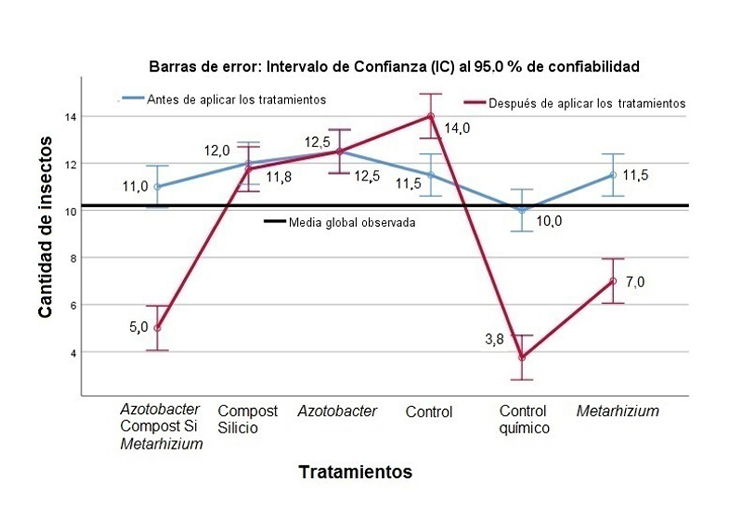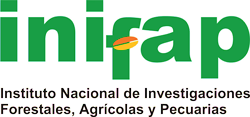Potassium silicate to control Oebalus insularis Stål in rice in Quevedo, Ecuador
DOI:
https://doi.org/10.29312/remexca.v16i3.3653Keywords:
Metarhizium anisopliae, Oebalus insularis Stål, Oryza sativa L., rice stink bugAbstract
Oebalus insularis Stål, colloquially known as the rice stink bug, causes damage to rice crops, the production losses of which can range between 30 and 65%, which is why agroecological alternatives for its control without the application of polluting synthetic chemicals are increasing. The research aimed to assess the use of beneficial microorganisms and compost with silicon for the control of O. insularis Stål, in Oryza sativa L., cultivar INIAP-14. The research was conducted in the summer-autumn 2023 in Quevedo, Ecuador, under field conditions in a clay loam soil, using six treatments consisting of a control without any application (T1), Buffago insecticide at 0.5 L ha-1 (T2); Azotobacter chroococcum, strain Ag, at 1 x 109 CFU ml-1 (T3); liquid compost with potassium silicate (K4SiO4) at 5 L ha-1 (T4); Metarhizium anisopliae, strain 45, at 1.2 L ha-1 (T5), and a combined treatment with A. chroococcum, liquid compost with potassium silicate, and M. anisopliae (T6), in a completely randomized design. The dependent variable evaluated was the number of insects per plot before and after applying the treatments. The results show a significant variation in the insect population before and after applying the treatments, with differentiated results between treatments, indicating that the use of combined treatments and that with Metarhizium show effective results to be considered as an agroecological alternative in the control of Oebalus insularis bug.
Downloads
References
Abada, K. A. and Eman, O. E. 2017. Effect of the combination among compost, bioagents and soil solarization on management of strawberry Verticillium wilt. International Journal of Scientific & Engineering Research. 8(2):88-99.
Acuña-Jiménez, M.; García-Gutiérrez, C.; Rosas-García, N.; López-Meyer, M. and Saínz-Hernández, J. 2015. Formulación de Metarhizium anisopliae (Metschnikoff) Sorokin con polímeros biodegradables y su virulencia contra Heliothis virescens (Fabricius). Revista Internacional de Contaminación Ambiental. 31(3):219-226.
Akram, M.; Rizvi, R.; Sumbul, A.; Ansari, R. A. and Mahmood, I. 2016. Potential role of bio-inoculants and matter for the management of root-knot nematode infesting chickpea. Cogent Food and Agriculture. 2(1):1-13. https://doi.org/10.1080/23311932.2016.1183457.
Álvarez-Sánchez, A. R.; Llerena-Ramos, L. T. y Reyes-Pérez, J. J. 2021. Efecto de sustancias azucaradas en la descomposición de sustratos orgánicos para la elaboración de compost. Terra Latinoamericana. 39(1):1-10. https://doi.org/10.28940/terra.v39i0.916.
Ahmad, P.; Ahanger, M. A.; Alam, P.; Alyemeni, M. N.; Wijaya, L.; Ali, S. and Ashraf, M. 2019. Silicon (Si) supplementation alleviates NaCl toxicity in mung bean [Vigna radiata (L.) Wilczek] through the modifications of physio-biochemical attributes and key antioxidant enzymes. Journal of Plant Growth Regulation. 38(1):70-82. https://doi.org/10.1007/s00344-018-9810-2.
Aslam, Z. and Ahmad, A. 2020. Effects of vermicompost, vermi-tea and chemmical fertilizer on morpho-physiological characteristics of maize (Zea mays L.) in Suleymanpasa District, Tekirdag of Turkey. Journal of Innovative Science. 6(1):41-46. https://doi.org/10.17582/journal.jis/2020/6.1.41.46.
Ateş, C.; Kaymaz, O.; Emre, K. H. and Agah, T. M. 2019. Comparison of test statistics of nonnormal and unbalanced samples for multivariate analysis of variance in terms of type-I error rates. Computational and Mathematical Methods in Medicine. 21(7):30-38. Doi.org/10.1155/2019/2173638.
Bhavanam, S. and Stout, M. J. 2022. Varietal resistance and chemical ecology of the rice stink bug, Oebalus pugnax, on rice, Oryza sativa. Plants. 11(5):270-277. Doi.org/10.3390/plants11223169.
Cárdenas-Castro, M. y Arancibia-Martini, H. 2014. Potencia estadística y cálculo del tamaño del efecto en G∗ Power: complementos a las pruebas de significación estadística y su aplicación en Psicología. Salud & Sociedad. 5(2):210-244. Doi.org/10.22199/S07187475.2014.0002.00006.
Christensen, R. 2022. Comment on ‘on the power of the F-test for hypotheses in a linear model’ by Griffiths and Hill. The American Statistician. 76(3):310-311. https://ideas.repec.org/a/taf/amstat/v76y2022i3p310-311.html.
Edison-Zambrano, C.; Andrade-Arias, M. y Carreño-Rodríguez, W. 2019. Factores que inciden en la productividad del cultivo de arroz en la provincia Los Ríos. Revista Universidad y Sociedad. 11(5):270-277.
Hajjar, M. J.; Ahmed, N.; Alhudaib, K. A. and Ullah, H. 2023. Insect pest management techniques for rice. Sustainability. 15(1):44-49. Doi.org/10.3390/su15054499.
Hasanuzzaman, M.; Bhuyan, M. H. M. B.; Nahar, K.; Hossain, M. S.; Mahmud, J. A.; Hossen, M. S.; Masud, A. A. C.; Moumita, M. D. and Fujita, M. 2018. Potassium: a vital regulator of plant responses and tolerance to abiotic stresses. Agronomy. 8(3):31-39. Doi.org/10.3390/agronomy8030031.
IBM-International Business Machines. 2019. SPSS for windows. Release 26. Chicago, SPSS Inc.
INANHI. 2021. Instituto Nacional de Meteorología e Hidrología. Anuario meteorológico del Cantón Mocache. Mocache, Los Ríos Ecuador. In: Pichilingue, E. E. T. Ed. 12 p.
Krinski, D. and Amilton-Foerster, L. 2017. Quantitative and qualitative damage caused by Oebalus poecilus (Hemiptera, Pentatomidae) to upland rice cultivated in new agricultural frontier of the Amazon rainforest (Brazil). Ciência e Agrotecnologia. 41(3):300-311. Doi.org/10.1590/1413-70542017413036816.
Llerena-Ramos, L.; Reyes-Pérez, J.; Álvarez-Sánchez, A. y Pincay-Ganchoso, R. 2021. Respuesta agronómica del cultivo del arroz a la inoculación con bacterias promotoras del crecimiento vegetal. Centro Agrícola. 48(4):5-10.
McGuire, A. V. and Northfield, T. D. 2021. Identification and evaluation of endemic Metarhizium strains for biological control of banana rust thrips. Biological Control. 162(1):104712-104721. Doi.org/10.1016/j.biocontrol.2021.104712.
Mendoza-Avilés, H.; Loor-Bruno, Á. y Vilema-Escudero, S. 2019. El arroz y su importancia en los emprendimientos rurales de la agroindustria como mecanismo de desarrollo local de Samborondón. Revista Universidad y Sociedad. 11(1):324-330.
Mukarram, M.; Petrik, P.; Mushtaq, Z.; Masroor, M.; Gulfishan, M. and Lux, A. 2022. Silicon nanoparticles in higher plants: uptake, action, stress tolerance, and crosstalk with phytohormones, antioxidants, and other signalling molecules. Environmental Pollution. 310 p. Doi.org/10.1016/j.envpol.2022.119855.
Ranjan, A.; Sinha, R.; Bala, M.; Pareek, A.; Singla-Pareek, S. L. and Singh, A. K. 2021. Silicon-mediated abiotic and biotic stress mitigation in plants: underlying mechanisms and potential for stress resilient agriculture. Plant Physiology and Biochemistry. 163(1):15-25. Doi.org/10.1016/j.plaphy.2021.03.044.
Rodríguez-Delgado, I.; Pérez-Iglesias, H. I. y Socorro-Castro, A. R. 2018. Principales insectos plaga, invertebrados y vertebrados que atacan el cultivo del arroz en Ecuador. Revista Científica Agroecosistemas. 6(1):95-107.
Romero-Cortes, T.; Pérez-España, V. H.; Peralta-Gil, M.; Aparicio-Burgos, J. E. y Cuervo-Parra. J. A. 2022. Caracterización morfológica y evaluación fenológica de accesiones de Teocintle (Zea spp.) cultivadas en Apan, México. Tropical and Subtropical Agroecosystems. 25(3):106-125. Doi.org/10.56369/tsaes.4147.
Ruilova-Cueva, M.; Cobos-Mora, F. y Gómez-Villalba, J. 2022. Manejo en el cultivo del arroz. Editorial Universidad Técnica de Babahoyo, Ecuador. Primera Edición. ISBN:978-9942-606-08-2 (eBook). 180 p.
Salim, B. B. M.; Hikal, M. S. and Osman, H. S. 2019. Ameliorating the deleterious effects of saline water on the antioxidants defence system and yield of eggplant using foliar application of zinc sulphate. Annals of Agricultural Science. 64(2):244-251.
Sumbul, A.; Ansari, R. A.; Rizvi, R. and Mahmood, I. 2020. Azotobacter: A potential bio-fertilizer for soil and plant health management. Review. Saudi Journal of Biological Sciences. 27(12):3634-3640. Doi.org/10.1016/j.sjbs.2020.08.004.
Tenguri, P.; Chander, S.; Kumar, E. R.; Yele, Y.; Pattathanam, S. A.; Tadagavadi, N. M.; Subramanian, S. and Suresh S. S. 2023. Effect of silicon application to the rice plants on feeding behaviour of the brown planthopper, Nilaparvata lugens (Stål) under elevated CO2. Silicon. 15(1):5811-5820. Doi.org/10.1007/s12633-023-02480-w.
Valle-Ramírez, S. B.; Torres-Gutiérrez, R.; Caicedo-Quinche, W. O.; Abril-Saltos, R. V. and Sucoshañay-Villalba, D. J. 2020. Aislamiento y caracterización de Metarhizium spp. de cultivos de caña de azúcar y su patogenicidad contra Mahanarva andigena (Hemiptera: Cercopidae). Ciencia y Tecnología Agropecuaria. 23(1):2-18. Doi.org/10.21930/rcta.vol23-num1-art:2361.
Zhe-Yu, P.; Shu-Ting, H.; Jia-Ting, Ch.; Ni, L.; Yong, W.; Asad, N. and Sheng-Qun, D. 2022. An update of a green pesticide: Metarhizium anisopliae. All Life. 15(1):1141-1159. Doi.10.1080/26895293.2022.2147224.

Published
How to Cite
Issue
Section
License
Copyright (c) 2025 Revista Mexicana de Ciencias Agrícolas

This work is licensed under a Creative Commons Attribution-NonCommercial 4.0 International License.
The authors who publish in Revista Mexicana de Ciencias Agrícolas accept the following conditions:
In accordance with copyright laws, Revista Mexicana de Ciencias Agrícolas recognizes and respects the authors’ moral right and ownership of property rights which will be transferred to the journal for dissemination in open access. Invariably, all the authors have to sign a letter of transfer of property rights and of originality of the article to Instituto Nacional de Investigaciones Forestales, Agrícolas y Pecuarias (INIFAP) [National Institute of Forestry, Agricultural and Livestock Research]. The author(s) must pay a fee for the reception of articles before proceeding to editorial review.
All the texts published by Revista Mexicana de Ciencias Agrícolas —with no exception— are distributed under a Creative Commons License Attribution-NonCommercial 4.0 International (CC BY-NC 4.0), which allows third parties to use the publication as long as the work’s authorship and its first publication in this journal are mentioned.
The author(s) can enter into independent and additional contractual agreements for the nonexclusive distribution of the version of the article published in Revista Mexicana de Ciencias Agrícolas (for example include it into an institutional repository or publish it in a book) as long as it is clearly and explicitly indicated that the work was published for the first time in Revista Mexicana de Ciencias Agrícolas.
For all the above, the authors shall send the Letter-transfer of Property Rights for the first publication duly filled in and signed by the author(s). This form must be sent as a PDF file to: revista_atm@yahoo.com.mx; cienciasagricola@inifap.gob.mx; remexca2017@gmail.
This work is licensed under a Creative Commons Attribution-Noncommercial 4.0 International license.


